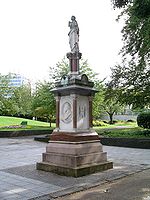James Starley
| James Starley | |
|---|---|

Statue commemorating James Starley in Coventry
|
|
| Born |
21 April 1830 Albourne, West Sussex, United Kingdom |
| Died |
17 June 1881 (aged 51) Coventry, West Midlands, United Kingdom |
| Nationality | British |
| Occupation | Inventor |
| Known for | Development of the Bicycle |
James Starley (21 April 1830 – 17 June 1881) was an English inventor and father of the bicycle industry. He was one of the most innovative and successful builders of bicycles and tricycles. His inventions include the differential gear and the perfection of the bicycle chain drive.
Starley was born in 1830 at Albourne, Sussex, the son of Daniel Starley, a farmer. He began working on the farm at nine, showing early talent as an inventor by making a rat trap from an umbrella rip and a branch of a willow tree. He ran away from home as a teenager and went to Lewisham, in south London. There he worked as an under-gardener, in his spare time mending watches and creating devices such as a mechanism to allow a duck to get through a hole in a fence, closing a door behind it if a rat tried to follow.
Starley's employer, John Penn, bought a rare and expensive sewing machine. Starley mended it when it broke down and improved the mechanism. Penn knew Josiah Turner, a partner of Newton, Wilson and Company, the makers of the machine, and in 1859 Starley joined its factory in Holborn. Turner and Starley started their own Coventry Sewing Machine Company in Coventry around 1861. Turner's nephew brought a new French bone-shaker to the factory in 1868. The company started making bicycles and Coventry soon became the centre of the British bicycle industry.
Velocipedes (cycles) had wheels of increasingly disparate size, with the front growing ever larger than the rear. Notable were the high-wheelers, or penny-farthings, a version of which Starley made with William Hillman. Their Ariel vehicle was all-metal and had wire-spoked wheels, much lighter than wooden-spoke ones. Tangent spokes were patented in 1874. Lever-driven and chain-driven tricycles, often in strange configurations, were also devised for women and couples.
...
Wikipedia
